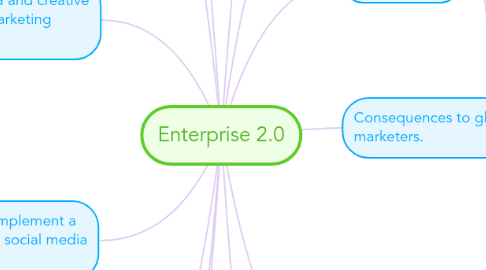
1. Benefits
1.1. Group editing: ability of a diverse set of people to collaborate on a single, centrally stored work product: a document, spreadsheet, presentation, or Web site.
1.2. Authoring: generating content and putting it online for a broad audience. Authoring is a public act.
1.2.1. Can take many forms, from sharing status updates using social networking software to posting photos, videos, and podcasts to writing a blog.
1.3. Broadcast search: is the inverse of authoring. Where people publicize not what they know, but instead what they don’t know. Is the posting of queries in a public forum in hopes of receiving an answer.
1.4. Network formation and maintenance: allows a searcher or browser to quickly identify people who could be valuable or helpful colleagues, based on their online track record.
1.5. Collective intelligence: use of technologies like prediction markets to generate answers from a dispersed group.
1.5.1. Collective intelligence is also used by many Web sites to identify “good” content.
1.6. Self-organization: ability of users to build valuable communities and resources and shape them over time, without having to rely on guidance from any center or headquarters.
1.6.1. Is not a concept that comes naturally to most enterprises, one of the key features of every enterprise is hierarchy, or a predefined and largely stable structure.
2. Enterprise 2.0 is not a substitute for formal organization, but rather a highly valuable complement to it
3. Obstacles to achieving of an organization
3.1. Not everyone within an organization wants information to flow and grow more freely
3.2. The well-documented finding that even organizations that sincerely want to change and become more open and transparent often have great difficulty doing so.
4. The Liar’s Club and Enterprise 2.0
4.1. Members of the liar’s club hoped someone else would be forced to admit problems first
4.2. This club is precisely the kind of information hiding that becomes much more difficult with Enterprise 2.0.
4.3. The organization could pursue the Enterprise 2.0 benefit of collective intelligence and so deploy prediction markets on the intranet.
4.4. The results from Enterprise 2.0 are the revelation of information runs counter to the liar’s club, and threatens it.
4.5. Enterprise 2.0, is also the responsibility of senior executives, not lower-level managers or IT department employees. The actions and responses of these executives will be closely watched.
5. Effects caused
5.1. Shift in locus of activity from the desktop to the Web
5.2. Shift in locus of value production from the firm to the consumer
5.3. Shift in the locus of power away from the firm to the consumer
6. Consequences to global marketers.
6.1. Social media
6.1.1. Comprise both the conduits and the content disseminated through interactions between individuals and organizations
6.2. Creative consumers
6.2.1. Are the new locus of value in Web 2.0. The dynamos of this new media world
7. Axioms for using social media and creative consumers in international marketing strategy
7.1. Social media is a function of the technology, culture, and government of a particular country.
7.2. In the age of social media, local events seldom remain local.
7.3. In the age of social media, general issues seldom remain general; that is, macro issues tend to be (re)interpreted locally.
7.4. The actions and creations of creative consumers tend to be a function of the technology, culture, and government of a particular country.
7.5. Technology tends to be historically dependent; that is, technologies in different countries evolve along unique trajectories due to inertia rather than because they are the optimal solution.
8. Recommendations to implement a successful international social media strategy
8.1. International marketing strategists understand the technology that underpins social media and creative consumers
8.2. Understand the consumer.
8.3. Understand social media
9. Barriers to the implementation of a successful international social media strategy
9.1. Attitude and language of engagement
9.2. The successful implementation of social media plans has to do with technology.
9.3. Bureaucracy is an impediment to the implemen- tation of social media plans.
9.4. Employees lack IT and commu- nication skills.
9.5. No knowledge of the "digital divide"
9.6. Senior decision makers in some organizations see social media as the wasteful pastime of teenagers
10. Enterprise 2.0 and the Shift from Model 1 to Model 2
10.1. In a series of detailed long-term studies he demonstrated that even with the best of intentions, organizations and the people within them fall into traps that keep them locked in unproductive patterns of behavior and interaction.
10.2. Model 1 is a theory-in-use rather than an espoused theory; in other words, it’s what people actually do, regardless of what they say they are doing.
10.2.1. The logic of Model 1 is: 1. Send a message that is inconsistent. 2. Act as if it is not inconsistent. 3. Make steps 1 and 2 undiscussable and make undiscussable discussable.
10.3. Model 2 does not reject the skill or competence to advocate one’s purposes. It seeks to alter views in order to base them on the most complete and valid information possible and to construct the positions to which people involved can become internally committed
10.3.1. The behavioral strategies of Model 2 involve power sharing with anyone who has the competence and is relevant to deciding about implementing the action in question
